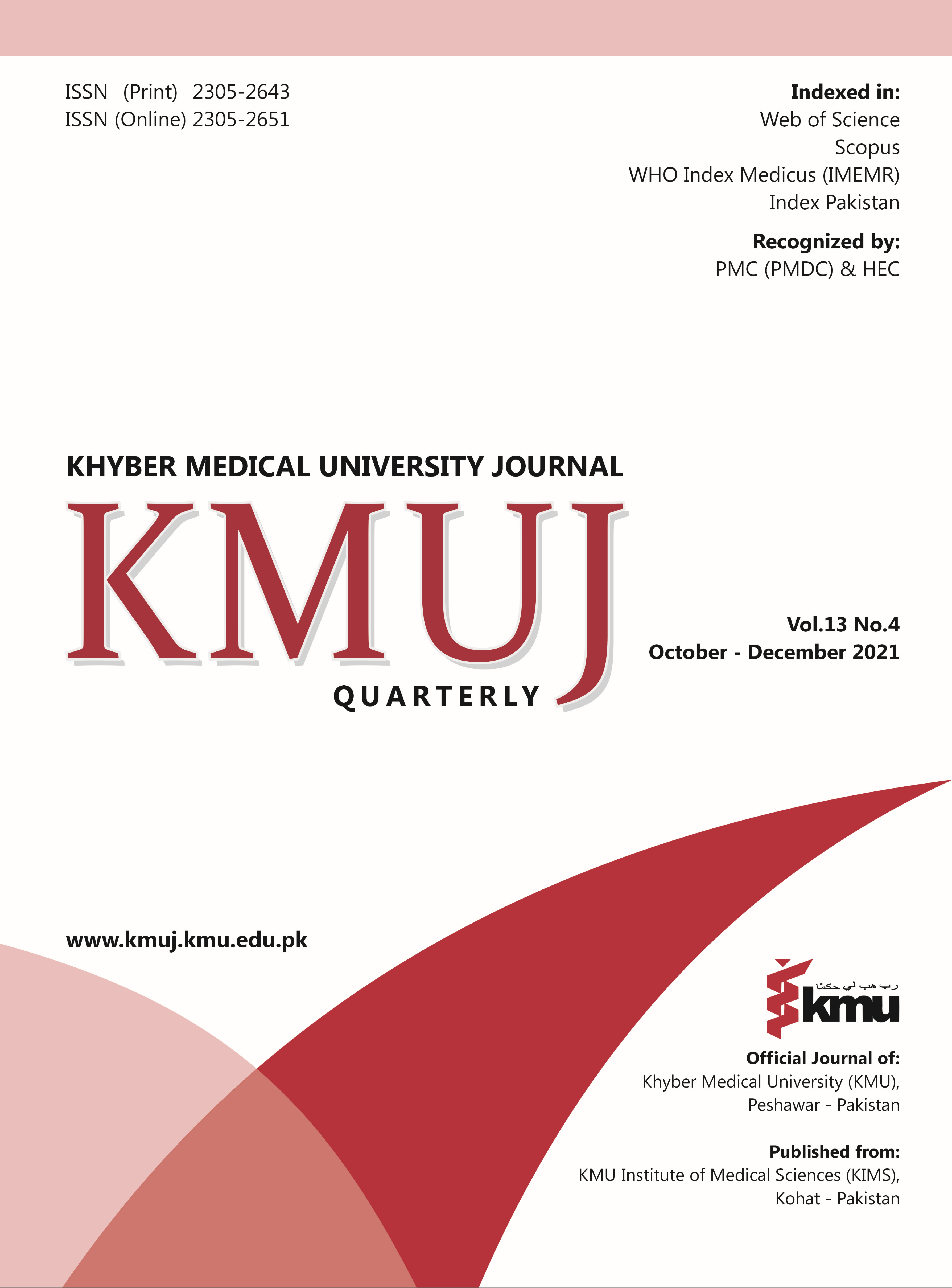OSTEOPOROSIS WITHIN A COHORT OF POSTMENOPAUSAL PAKISTANI WOMEN USING DUAL X-RAY BONE DENSITOMETRY
Main Article Content
Abstract
OBJECTIVE: To explore the prevalence of osteopenia and osteoporosis within a cohort of Pakistani postmenopausal women with respect to the lumbar spine and hip.
METHODS: This cross-sectional study was conducted at Shifa International Hospital Islamabad, Pakistan from September 2019 to Feb 2020. Study comprised of 237 postmenopausal females who visited the outpatient department of the hospital. The T-scores of Bone Mineral density (BMD) data was collected and arranged in three groups: normal, osteopenia and osteoporosis. Data was analyzed to explore the distribution of the data and correlation analyses using R software version 3.6.3.
RESULTS: Out of 237 females, majority were ranging in age from 61-70 years (n=110; 46.4%), followed by 51-60 years age group (n=60; 25.3%). Osteopenia was noted in 98 (41.4%) cases in lumber spine and hip area. Osteoporosis was found in 79 (33.3%) and 59 (24.9%) cases in lumber spine and hip region respectively. Mean T score was -1.775±-2.000 and median T score was -1.469 for lumber spine and hip. T-scores distribution of lumbar spine and hip indicated the highest proportion having a sore of -2 SD (n=60; 25.3% each), followed by -3 SD in 52 (21.9%) cases. Bone mass density was negatively correlated with age (p≤0.01). However, no significant difference was found among the BMD values of lumbar spine and hip region.
CONCLUSION: Decreased bone density was a common occurrence affecting postmenopausal females and there is increase in degenerative bone loss with increasing age. Hip and lumbar spine region are equally affected by degenerative bone loss.
Article Details
Work published in KMUJ is licensed under a
Creative Commons Attribution 4.0 License
Authors are permitted and encouraged to post their work online (e.g., in institutional repositories or on their website) prior to and during the submission process, as it can lead to productive exchanges, as well as earlier and greater citation of published work.
(e.g., in institutional repositories or on their website) prior to and during the submission process, as it can lead to productive exchanges, as well as earlier and greater citation of published work.
References
NIH Consensus Development Panel on Osteoporosis Prevention, Diagnosis, and Therapy. Osteoporosis prevention, diagnosis, and therapy. J Am Med Assoc 2001;285(6):785-95. https://doi.org/10.1001/jama.285.6.785.
Cosman F, de Beur SJ, LeBoff MS,Lewiecki EM, Tanner B, Randall S, et al. Clinician's Guide to Prevention and Treatment of Osteoporosis [published correction appears in Osteoporos Int 2015;26(7):2045-7]. Osteoporos Int 2014;25(10):2359-81. https://doi.org/10.1007/s00198-014-2794-2.
Sözen T, Özışık L, Başaran NÇ. An overview and management of osteoporosis. Eur J Rheumatol 2017;4(1):46-56. https://doi.org/10.5152/eurjrheum.2016.048.
Karaguzel, G., Holick, M.F. Diagnosis and treatment of osteopenia. Rev Endocr Metab Disord 2010;11: 237-51. https://doi.org/10.1007/s11154-010-9154-0
Hernlund E, Svedbom A, Ivergård M, Compston J, Cooper C, Stenmark J, et al. Osteoporosis in the European Union: medical management, epidemiology and economic burden. A report prepared in collaboration with the International Osteoporosis Foundation (IOF) and the European Federation of Pharmaceutical Industry Associations (EFPIA). Arch Osteoporos 2013;8(1):136. https://doi.org/10.1007/s11657-013-0136-1.
Mithal A, Bansal B, Kyer CS, Ebeling P. The Asia-Pacific Regional Audit-Epidemiology, Costs, and Burden of Osteoporosis in India 2013: A report of International Osteoporosis Foundation. Indian J Endocrinol Metab 2014;18(4):449-4. https://doi.org/10.4103/2230-8210.137485.
Lems WF, Raterman HG, van den Bergh JPW, Bijlsma HWJ, Valk NK, Zillikens MC, et al. Osteopenia: a diagnostic and therapeutic challenge. Curr Osteoporos Rep 2011;9(3):167-72.
Dobbs MB, Buckwalter J, Saltzman C. Osteoporosis: the increasing role of the orthopaedist. Iowa Orthop J 1999;19:43-52.
R Development Core Team. R: A language and environment for statistical computing. Vienna, Austria: R Foundation for Statistical Computing; 2010.
Kanis JA, Melton LJ 3rd, Christiansen C, Johnston CC, Khaltaev N. The diagnosis of osteoporosis. J Bone Miner Res 1994;9(8):1137-41. https://doi.org/10.1002/jbmr.5650090802.
Thacker HL, Richmond B. In rebuttal: Osteopenia is a useful diagnosis. Cleveland Clinic J Med 2006;73(1):34-6.
Cummings SR, Black DM, Rubin SM. Lifetime risks of hip, Colles', or vertebral fracture and coronary heart disease among white postmenopausal women. Arch Intern Med 1989;149(11):2445-8.
Alswat KA. Gender Disparities in Osteoporosis. J Clin Med Res 2017;9(5):382-7. https://doi.org/10.14740/jocmr2970w.
Aggarwal N, Raveendran A, Khandelwal N, Sen RK, Thakur JS, Dhaliwal LK, Singla V, Manoharan SR. Prevalence and related risk factors of osteoporosis in peri- and postmenopausal Indian women. J Midlife Health 2011 Jul;2(2):81-5. https://doi.org/10.4103/0976-7800.92537.
Khadilkar AV, Mandlik RM. Epidemiology and treatment of osteoporosis in women: an Indian perspective. Int J Womens Health 2015;7:841-50. https://doi.org/10.2147/IJWH.S54623.
Begum RA, Ali L, Akter J, Takahashi O, Fukui T, Rahman M. Osteopenia and osteoporosis among 16-65 year old women attending outpatient clinics. J Community Health 2014;39(6):1071-6. https://doi.org/10.1007/s10900-014-9853-7.
Rozenberg S, Al-Daghri N, Aubertin-Leheudre M, Brandi ML, Cano A, Collins P, et al. Is there a role for menopausal hormone therapy in the management of postmenopausal osteoporosis? Osteoporos Int 2020;31(12):2271-86. https://doi.org/10.1007/s00198-020-05497-8.
Khan AH, Jafri L, Ahmed S, Noordin S. Osteoporosis and its perspective in Pakistan: A review of evidence and issues for addressing fragility fractures. Annals Med Surg 2018;29:19-25. https://doi.org/10.1016/j.amsu.2018.03.019
Nakagi Y, Ito T, Hirooka K, Sugioka Y, Endo H, Saijo Y, et al. Association between lifestyle habits and bone mineral density in Japanese juveniles. Environ Health Prev Med 2010;15(4):222-8. https://doi.org/10.1007/s12199-009-0131-8.
Kim KC, Shin DH, Lee SY, Im JA, Lee DC. Relation between obesity and bone mineral density and vertebral fractures in Korean postmenopausal women. Yonsei Med J 2010;51(6):857-63. https://doi.org/10.3349/ymj.2010.51.6.857.
Naeem ST, Hussain R, Raheem A, Siddiqui I, Ghani F, Khan AH. Bone turnover markers for osteoporosis status assessment at baseline in postmenopausal Pakistani females. J Coll Physicians Surg Pak 2016;26(5):408-12.
Lateef M, Baig M, Azhar A. Estimation of serum osteocalcin and telopeptide-C in postmenopausal osteoporotic females. Osteoporos Int 2010;21(5):751-5. https://doi.org/10.1007/s00198-009-1001-3.
Ma X-H, Zhang W, Wang Y, Xue P, Li Y-K. Comparison of the Spine and Hip BMD Assessments Derived from Quantitative Computed Tomography. Int J Endocrinol 2015;2015:675340. https://doi.org/10.1155/2015/67534.
Namwongprom S, Ekmahachai M, Vilasdechanon N, Klaipetch A, Wongboontan C, Boonyaprapa S. Bone mineral density: correlation between the lumbar spine, proximal femur and Radius in northern Thai women. J Med Assoc Thai 2011;94(6):725-31.
